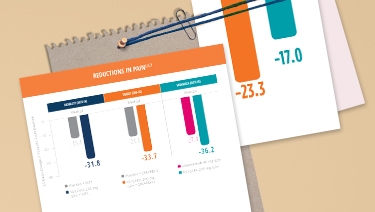
and safety data up to 7 years with no
unexpected safety signals
COMMON ADVERSE REACTIONS IN PRE-RESCUE, PLACEBO-CONTROLLED TRIALS1*
*Adverse reactions occurring in ≥2% of patients administered KEVZARA 200 mg or KEVZARA 150 mg + DMARD(s) and greater than observed in patients on placebo + DMARD(s).
- Medically relevant AE occurring at an incidence of less than 2% in patients with RA treated with KEVZARA in controlled studies was oral herpes1
- Decrease in ANC was not associated with higher incidence of infections, including serious infections1
- In the long-term safety population, the overall rates of serious infections, GI perforations, neutrophil counts, platelet counts, and lipid parameters were consistent with what was observed in the placebo-controlled trials1
DMARDs=disease-modifying antirheumatic drugs; ALT=alanine aminotransferase; ANC=absolute neutrophil count; GI=gastrointestinal.
Studied in ≈3000 MTX-IR and TNF-IR patients with over 8100 patient-years of exposure1-3
Mean duration of treatment in the safety population (N=2887) was 2.8 years (max 7.3 years), representing 8188 cumulative PY of exposure
- 773 patients (27%) were treated for ≥240 weeks (4.6 years)
- 36 patients (1.2%) were treated for >360 weeks (7 years)
Incidence rate of AEs was generally stable over time, with no indication of increased incidence rate in serious AEs and serious infections.2,3
MOBILITY (MTX-IR), TARGET (TNF-IR), LONG-TERM SAFETY POPULATIONS2,3

In the long-term safety population, the rate of thromboembolic events (MedDRA high-level group term “embolism and thrombosis”) was 0.8 per 100 PY (as reported and evaluated post hoc; not a prespecified AESI)2
- Rate of DVT was 0.2 per 100 PY; rate of PE was 0.2 per 100 PY
Safety observations in the open-label extension population were consistent with those in the placebo-controlled trials.2,3
*Incidence rate per 100 PY at risk of first event.
†TEAE period from day of first treatment dose to 60 days after the last treatment dose.2
‡Injection site reactions (including erythema and pruritus) were mild in severity for the majority of patients and necessitated drug discontinuation in 3 (<0.5%) patients receiving KEVZARA.3
MTX-IR=methotrexate inadequate response; TNF-IR=tumor necrosis factor inhibitor inadequate response or intolerant; PY=patient-years; IR=incidence rate; MTX=methotrexate; DMARDs=disease-modifying antirheumatic drugs; q2w=every 2 weeks; TEAE=treatment-emergent adverse event; ALT=alanine aminotransferase; AESI=adverse event of special interest; DVT=deep vein thrombosis; PE=pulmonary embolism.
MONARCH: NO UNEXPECTED SAFETY SIGNALS WITH KEVZARA
Overall, KEVZARA monotherapy long-term safety was studied in 471 patients, with ≈800 patient-years of exposure, and data were consistent with MONARCH studies1
Mean exposure in the long-term safety population was 1.7 years (max 3.5 years)
- 320 patients (87%) were treated for ≥72 weeks
Incidence rate of AEs was generally stable over time, with no indication of increased incidence rate2,3
MONARCH (MTX-IR) AND MONARCH LONG-TERM SAFETY POPULATIONS2,3*†

In MONARCH, the safety profiles of KEVZARA and adalimumab were generally comparable, except for neutropenia and injection site erythema for KEVZARA and headache and RA for adalimumab3
Safety observations in the long-term population were generally consistent with those in the randomized, controlled population.4
*Adverse events reported for the long-term safety population were selected based on occurrence in ≥3% of patients in the randomized, controlled population in any treatment group; †Patients from the KEVZARA ONE study population were included in these long-term monotherapy safety data; ‡One patient was randomized, but not treated, in the adalimumab group and was not included in the safety population; §Patient years per group are as follows: 80.5 (adalimumab 40 mg), 80.1 (KEVZARA 200 mg), and 348.1 (long-term safety population for KEVZARA 200 mg). ||In the randomized trial, 1 patient in the KEVZARA group died of acute cardiac failure secondary to aortic dissection and papillary muscle rupture on day 36; ¶In the randomized trial, 1 patient receiving KEVZARA was diagnosed with infective bursitis and another patient was diagnosed with mastitis, and 1 patient receiving adalimumab was diagnosed with bacterial arthritis and another patient was diagnosed with a respiratory tract infection; #Protocol defined as ≥2 doses within 11 calendar days or within 6 days for adalimumab-treated patients who switched to weekly dosing; Dyslipidemia was defined by standardized MedDRA query.2,3
MTX-IR=methotrexate inadequate response; q2w=once every 2 weeks; PY=patient-years; IR=incidence rate; TEAE=treatment emergent adverse event; ALT=alanine aminotransferase.